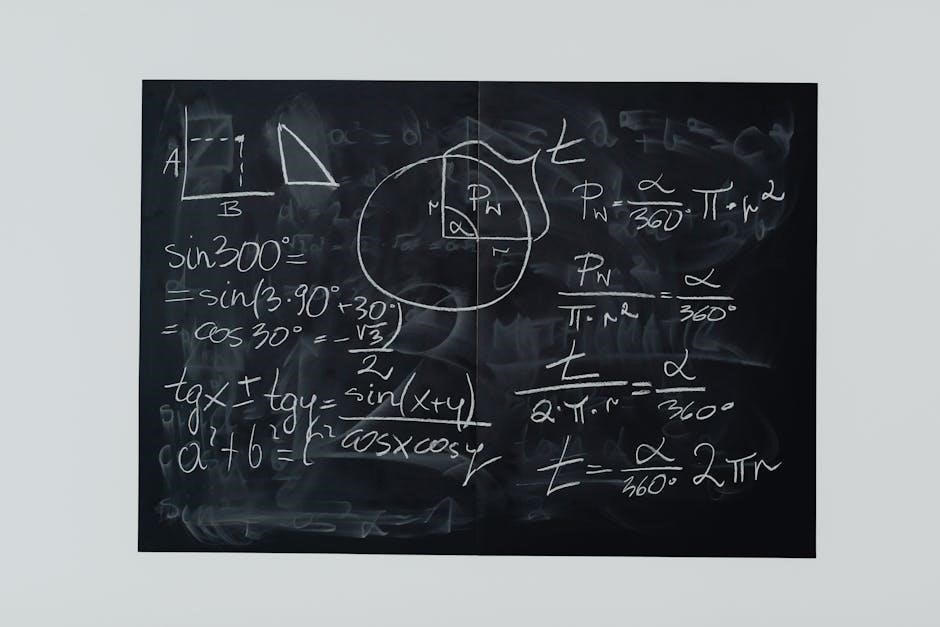Michael Spivak’s Calculus is a renowned textbook that presents a rigorous and elegant introduction to single-variable calculus. First published in 1967, it has become a classic in mathematics education, admired for its clarity, depth, and intuitive approach. The book emphasizes proofs and foundational concepts, making it a favorite among students and instructors seeking a thorough understanding of the subject. Spivak’s writing style is exceptional, blending rigor with readability, and his ability to explain complex ideas with precision and grace sets the text apart from more procedural treatments of calculus.
The fourth edition, released in 2008, includes additional problems, updated suggested reading, and refined explanations in key chapters; It remains a cornerstone for self-study and advanced coursework, offering a rich exploration of calculus as a cohesive intellectual framework.

- Key Features: Rigorous proofs, intuitive explanations, and a focus on conceptual understanding.
- Editions: The fourth edition is widely regarded as the most comprehensive, with enhanced problem sets and updated content.
- Impact: Spivak’s Calculus has inspired generations of mathematicians and educators, earning praise for its beauty and precision.

For those seeking a deep, rewarding journey into the heart of calculus, Spivak’s masterpiece remains an indispensable resource.
Overview of the Textbook
Michael Spivak’s Calculus is a seminal work in mathematics education, offering a comprehensive and rigorous exploration of single-variable calculus. First published in 1967, the textbook has undergone several revisions, with the fourth edition (2008) being the most widely used and celebrated version. This edition builds on the foundational principles established in earlier versions, incorporating additional problems, updated references, and refined explanations in key chapters such as Chapter 5 on differentiation and Chapter 20 on exponential functions.
The textbook is structured to present calculus as a cohesive and evolving discipline rather than a collection of disjointed topics. Spivak begins with the fundamentals of analysis, including properties of real numbers, sequences, and limits, laying a solid groundwork for the study of differentiation and integration. The text progresses through the core concepts of calculus, including continuity, differentiation, and integration, while also exploring more advanced topics such as infinite series, differential equations, and the applications of calculus to physics and other sciences. Optional chapters delve into the properties of real numbers and the historical development of calculus, providing a well-rounded understanding of the subject.
One of the defining features of Calculus is its emphasis on rigor and precision. Unlike many introductory calculus textbooks, which often prioritize procedural fluency over conceptual understanding, Spivak’s approach demands that students engage deeply with the underlying principles and proofs. For example, the text includes detailed proofs of the Intermediate Value Theorem, the Mean Value Theorem, and the Fundamental Theorem of Calculus, ensuring that students appreciate the logical structure of calculus. This focus on rigor makes the book particularly suitable for students preparing for advanced studies in mathematics or related fields.

The textbook is also notable for its clear and elegant writing style. Spivak’s prose is celebrated for its clarity and accessibility, making complex ideas understandable to readers who are willing to invest the necessary effort. He often introduces concepts with intuitive explanations before transitioning to formal definitions and proofs, a technique that helps bridge the gap between informal understanding and mathematical rigor. For instance, in Chapter 20, Spivak introduces the concept of the irrationality of ( e ) with a thought-provoking discussion that motivates the reader to engage with the proof.
The exercises in Calculus are another hallmark of the textbook. They are challenging and thought-provoking, designed to test not only computational skills but also the ability to think critically and solve problems creatively. Many exercises require students to construct proofs or explore the implications of calculus concepts in novel contexts. While the problems can be demanding, they are carefully crafted to reinforce key ideas and encourage a deeper understanding of the material. For students engaged in self-study, a companion solutions manual is available, providing detailed explanations and solutions to many of the exercises.
Another unique aspect of Spivak’s Calculus is its integration of historical and philosophical perspectives. The optional chapter on the history of calculus, for example, provides insights into the intellectual journey that led to the development of calculus, highlighting the contributions of key figures such as Newton, Leibniz, and their predecessors. This historical context not only enriches the learning experience but also underscores the significance of calculus as a cornerstone of modern mathematics.
The textbook’s design and layout also contribute to its effectiveness as a learning tool. The text is complemented by figures and diagrams that are placed strategically to illustrate key concepts, such as the behavior of functions, the geometry of integration, and the relationship between limits and continuity. The use of margins for definitions, theorems, and key equations enhances readability and makes it easier for students to navigate the material. This attention to detail reflects Spivak’s commitment to creating a textbook that is both informative and visually engaging.

Importance in Mathematics Education
Michael Spivak’s Calculus holds a significant place in mathematics education due to its rigorous and elegant presentation of single-variable calculus. This textbook is not merely a resource for learning calculus; it is an intellectual journey that fosters deep understanding, critical thinking, and a genuine appreciation for the beauty of mathematics. Spivak’s approach has made it a cornerstone in mathematics education, particularly for students seeking a thorough and rigorous introduction to calculus.

The importance of Calculus lies in its ability to bridge the gap between high school mathematics and university-level analysis. Spivak’s emphasis on proofs and foundational concepts prepares students for more advanced studies in mathematics, physics, and engineering. By focusing on the “why” behind the calculations, the text encourages students to think like mathematicians, developing skills in logical reasoning and problem-solving that are invaluable in any scientific discipline. For instance, the detailed proofs of key theorems, such as the Intermediate Value Theorem and the Fundamental Theorem of Calculus, provide students with a robust understanding of the subject’s logical structure.
The textbook’s rigorous approach is particularly beneficial for students transitioning to higher-level mathematics. Many calculus texts prioritize procedural fluency, often at the expense of conceptual understanding. In contrast, Spivak’s Calculus demands that students engage with the underlying principles of analysis, ensuring that they grasp the fundamental ideas that underpin calculus. This focus on rigor makes the text especially suitable for students preparing for careers in mathematics, physics, or computer science, where a deep understanding of mathematical concepts is essential.
Another aspect of the textbook’s importance is its role in fostering critical thinking and problem-solving skills. The exercises in Calculus are notoriously challenging, requiring students to apply concepts creatively and think deeply about the material. These problems are not mere computations; they often involve constructing proofs, exploring the implications of calculus concepts, or investigating the properties of functions. While the exercises can be demanding, they are carefully designed to reinforce key ideas and encourage intellectual growth. For example, the text’s exploration of infinite series and differential equations challenges students to apply calculus to real-world problems, preparing them for advanced studies and practical applications.
The availability of a companion solutions manual further enhances the textbook’s educational value. For students engaged in self-study or those who need additional support, the solutions manual provides detailed explanations and guidance, helping to clarify complex concepts and solidify understanding. This resource is particularly valuable for students who may not have access to instructor support, as it offers a pathway to mastery through independent study.

Spivak’s Calculus also plays a crucial role in bridging the gap between calculus and advanced analysis. The text introduces concepts such as limits, continuity, and integration with a level of rigor that prepares students for more abstract mathematical studies. For instance, the discussion of Riemann-Darboux integration and the treatment of limits superior and inferior provide students with a foundation in analysis that is essential for understanding measure theory and advanced calculus. This bridge between calculus and analysis makes the text a valuable resource for students pursuing higher-level mathematics.
Moreover, the textbook’s historical and philosophical insights add depth to the learning experience. Spivak’s inclusion of historical context, such as the development of calculus by Newton and Leibniz, provides students with a broader appreciation of the subject’s significance. This historical perspective not only enriches the learning process but also highlights the relevance of calculus in the broader narrative of scientific and mathematical discovery.